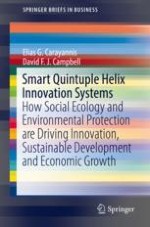This volume examines the relationships among social ecology, innovation, sustainable development and economic growth.
The Quintuple Helix innovation model focuses on the interactions among five key elements of society: academia, industry, government, culture, and the environment--with particular respect to harnessing knowledge to promote social, political, and economic development. The Quintuple Helix is a powerful theoretical and practical lens for analyzing and understanding such critical and complex ecological and socioeconomic issues as global warming and climate change and their implications for sustainability. The authors provide policy approaches and strategies to help create a balance among the often competing forces of environmental protection, innovation, entrepreneurship, and social and economic growth that will successfully benefit society and protect democratic values.
